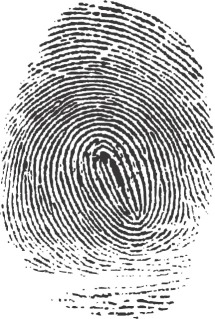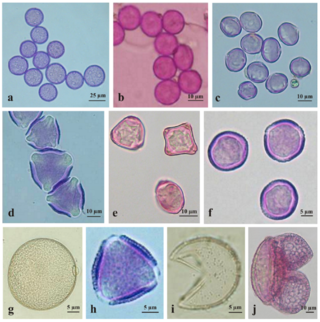
| Part of a series on |
| Forensic science |
|---|
 |
A pollen calendar is used to show the peak pollen times for different types of plant pollen, which causes allergic reactions in certain people. [1] [2] [3]

| Part of a series on |
| Forensic science |
|---|
 |
A pollen calendar is used to show the peak pollen times for different types of plant pollen, which causes allergic reactions in certain people. [1] [2] [3]
A pollen calendar can be a very useful tool in forensic science, because it can be used to place the month, or week, or date of death. [4] [5] The use of pollen for criminal investigation purposes is called "forensic palynology". [6] [4]
However, the use of a pollen calendar to set the date of death should be used with extreme caution, and only by a carefully trained expert witness. [7] The CSI effect has put pressure on some police officers and district attorneys to provide pollen-based evidence, but such evidence "appear[s] to be of limited use in the forensic context where outcomes are scrutinised in court." [7]

Forensic science, also known as criminalistics, is the application of science to criminal and civil laws. During criminal investigation in particular, it is governed by the legal standards of admissible evidence and criminal procedure. It is a broad field utilizing numerous practices such as the analysis of DNA, fingerprints, bloodstain patterns, firearms, ballistics, toxicology, and fire debris analysis.

Pollen is a powdery substance produced by flowers of seed plants. It consists of pollen grains, which produce male gametes. Pollen grains have a hard coat made of sporopollenin that protects the gametophytes during the process of their movement from the stamens to the pistil of flowering plants, or from the male cone to the female cone of gymnosperms. If pollen lands on a compatible pistil or female cone, it germinates, producing a pollen tube that transfers the sperm to the ovule containing the female gametophyte. Individual pollen grains are small enough to require magnification to see detail. The study of pollen is called palynology and is highly useful in paleoecology, paleontology, archaeology, and forensics. Pollen in plants is used for transferring haploid male genetic material from the anther of a single flower to the stigma of another in cross-pollination. In a case of self-pollination, this process takes place from the anther of a flower to the stigma of the same flower.
An allergen is a type of antigen that produces an abnormally vigorous immune response in which the immune system fights off a perceived threat that would otherwise be harmless to the body. Such reactions are called allergies.

Forensic palynology is a subdiscipline of palynology, that aims to prove or disprove a relationship among objects, people, and places that may pertain to both criminal and civil cases. Pollen can reveal where a person or object has been, because regions of the world, countries, and even different parts of a single garden will have a distinctive pollen assemblage. Pollen evidence can also reveal the season in which a particular object picked up the pollen.

Aerobiology is a branch of biology that studies the passive transport of organic particles, such as bacteria, fungal spores, very small insects, pollen grains and viruses. Aerobiologists have traditionally been involved in the measurement and reporting of airborne pollen and fungal spores as a service to those with allergies. However, aerobiology is a varied field, relating to environmental science, plant science, meteorology, phenology, and climate change.

A fingerprint is an impression left by the friction ridges of a human finger. The recovery of partial fingerprints from a crime scene is an important method of forensic science. Moisture and grease on a finger result in fingerprints on surfaces such as glass or metal. Deliberate impressions of entire fingerprints can be obtained by ink or other substances transferred from the peaks of friction ridges on the skin to a smooth surface such as paper. Fingerprint records normally contain impressions from the pad on the last joint of fingers and thumbs, though fingerprint cards also typically record portions of lower joint areas of the fingers.

Huntsville is a city in and the county seat of Walker County, Texas. The population was 45,941 as of the 2020 census. It is the center of the Huntsville micropolitan area. Huntsville is in the East Texas Piney Woods on Interstate 45 and home to Texas State Prison, Sam Houston State University, the Texas Department of Criminal Justice, Huntsville State Park, and HEARTS Veterans Museum of Texas.

Palynology is the study of microorganisms and microscopic fragments of mega-organisms that are composed of acid-resistant organic material and occur in sediments, sedimentary rocks, and even some metasedimentary rocks. Palynomorphs are the microscopic, acid-resistant organic remains and debris produced by a wide variety plants, animals, and Protista that have existed since the late Proterozoic.

Allergic rhinitis, of which the seasonal type is called hay fever, is a type of inflammation in the nose that occurs when the immune system overreacts to allergens in the air. Signs and symptoms include a runny or stuffy nose, sneezing, red, itchy, and watery eyes, and swelling around the eyes. The fluid from the nose is usually clear. Symptom onset is often within minutes following allergen exposure, and can affect sleep and the ability to work or study. Some people may develop symptoms only during specific times of the year, often as a result of pollen exposure. Many people with allergic rhinitis also have asthma, allergic conjunctivitis, or atopic dermatitis.

Nehemiah Grew was an English plant anatomist and physiologist, known as the "Father of Plant Anatomy".

A pollen count is a measurement of the number of pollen grains in a given volume of air. Pollen counts, and forecasts of pollen conditions, are routinely produced and reported to the public because high aerial pollen concentration is associated with increased rates of allergic reaction for those with conditions such as hay fever and asthma. The pollen counted are usually identified to family; particularly families with hyperallergenic pollen and families that are prevalent in the relevant area. Thunderstorm asthma events as well as mild winters with warmer days lead to increases in pollen counts, while colder winters lead to delayed pollen release. Though not pollen, hyperallergenic fungal spores such as those of Alternaria may be counted as well.

The University of Worcester is a public research university, based in Worcester, England. Worcester is the only university based in the counties of Worcestershire and Herefordshire. With a history dating back to 1946, the university began awarding degrees in 1997 and was granted full university status in 2005.

Digital forensics is a branch of forensic science encompassing the recovery, investigation, examination, and analysis of material found in digital devices, often in relation to mobile devices and computer crime. The term "digital forensics" was originally used as a synonym for computer forensics but has expanded to cover investigation of all devices capable of storing digital data. With roots in the personal computing revolution of the late 1970s and early 1980s, the discipline evolved in a haphazard manner during the 1990s, and it was not until the early 21st century that national policies emerged.
The following outline is provided as an overview of and topical guide to forensic science:
A DNA database or DNA databank is a database of DNA profiles which can be used in the analysis of genetic diseases, genetic fingerprinting for criminology, or genetic genealogy. DNA databases may be public or private, the largest ones being national DNA databases.

Tammy Jo Alexander was an American teenage girl who was found murdered in the village of Caledonia, New York on November 10, 1979. She had been fatally shot twice and left in a field just off U.S. Route 20 near the Genesee River after running away from her home in Brooksville, Florida, earlier that year. For more than three decades, she remained unidentified under the names Caledonia Jane Doe or Cali Doe until January 26, 2015, when police in Livingston County, New York, announced her identity 35 years after her death.
An aeroallergen is any airborne substance, such as pollen or spores, which triggers an allergic reaction.
Professor Patricia Wiltshire, is a forensic ecologist, botanist and palynologist. She has been consulted by police forces and industry in almost 300 investigations in several countries and has been instrumental in solving several high-profile crimes, including the killings of Sarah Payne and Millie Dowler, the cold case of Christopher Laverack, the Soham murders, and the Ipswich serial murders.

Forensic mycology is the use of mycology in criminal investigations. Mycology is used in estimating times of death or events by using known growth rates of fungi, in providing trace evidence, and in locating corpses. It also includes tracking mold growth in buildings, the use of fungi in biological warfare, and the use of psychotropic and toxic fungus varieties as illicit drugs or causes of death.
The National Pollen and Aerobiology Research Unit or NPARU is a research institute in Worcester. It produces the UK's pollen count, and was the world's first pollen forecasting service.